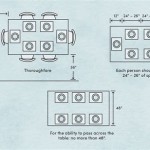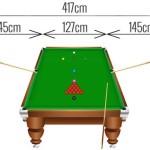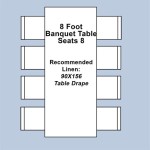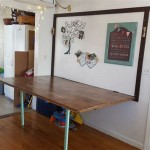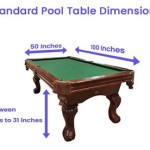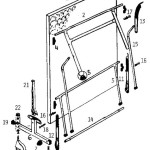What is a Trestle Table? A Comprehensive Guide
A trestle table is a type of table distinguished by its support system. Instead of having four legs directly attached to the tabletop at each corner, a trestle table relies on trestles – separate, often collapsible, support structures – to hold the tabletop. This design offers several advantages and has a rich history, making it a popular choice for a variety of settings, from homes and gardens to event venues and commercial spaces.
The term "trestle" refers to a braced frame structure. These frames are typically constructed from wood or metal and are designed to be strong and stable enough to support the weight of the tabletop and anything placed upon it. The tabletop itself can be made from various materials, including wood, metal, plastic, or even composite materials, depending on the intended use and aesthetic preference.
The defining characteristic of a trestle table is the separation of the tabletop and the support structure. This modular design allows for easy assembly, disassembly, and storage, making it a practical choice for situations where flexibility and portability are required.
Key Point 1: The Anatomy and Construction of a Trestle Table
To fully understand what a trestle table is, it's essential to examine its key components and how they are constructed. The primary elements are the tabletop and the trestles themselves.
The tabletop is the flat surface on which items are placed. Its dimensions and material composition can vary widely. For example, a dining trestle table might have a solid wood top, carefully crafted and finished to provide an elegant and durable surface. A trestle table intended for outdoor use might have a plastic or composite top that is resistant to weather damage. The size and shape of the tabletop can also vary considerably, ranging from small, square tables to long, rectangular tables suitable for seating multiple people.
The trestles are the supporting structures that hold the tabletop in place. Their design is critical to the stability and weight-bearing capacity of the table. A typical trestle consists of two legs connected by a horizontal support, often referred to as a stretcher or brace. The legs are typically angled outwards to provide a wider base of support, enhancing stability. The stretcher serves to connect the legs and prevent them from splaying apart under load.
The connection between the tabletop and the trestles can be achieved in several ways. In some designs, the tabletop simply rests on top of the trestles, relying on gravity and friction to hold it in place. This is common in situations where the table is frequently assembled and disassembled. In other designs, the tabletop may be attached to the trestles using screws, bolts, or other fasteners to create a more secure and permanent connection.
Materials used in trestle construction also vary. Wood is a common choice, particularly for traditional trestle tables. Wood offers a warm, natural aesthetic and can be easily worked and finished. Metal is another popular option, especially for more modern or industrial-style trestle tables. Metal trestles can be incredibly strong and durable and are often used in situations where heavy loads are expected. Plastic and composite materials are also used, particularly for trestles intended for outdoor use or where moisture resistance is important.
Key Point 2: Advantages and Disadvantages of Trestle Tables
Trestle tables offer several advantages that make them a popular choice for various applications. However, they also have some drawbacks that should be considered.
One of the primary advantages of trestle tables is their portability and ease of storage. Because the tabletop and trestles are separate components, they can be easily disassembled and transported. This makes trestle tables ideal for events, catering, and other situations where temporary tables are needed. When not in use, the trestles can be folded or stacked, and the tabletop can be stored flat, saving space.
Another advantage of trestle tables is their versatility. They can be used for a wide range of purposes, from dining and entertaining to crafting and displaying goods. The simple, adaptable design of a trestle table allows it to blend seamlessly into various environments. Different tabletops and trestle designs can be combined to create custom tables that meet specific needs and aesthetic preferences.
Trestle tables also offer a degree of adjustability. The height of the table can be adjusted by using different trestles or by placing shims under the legs. This can be useful in situations where the table needs to be level on uneven surfaces or when different users require different table heights.
However, trestle tables also have some disadvantages. Compared to tables with fixed legs, trestle tables can be less stable, particularly if the tabletop is not securely attached to the trestles. This can be a concern if the table is used in a high-traffic area or if heavy items are placed on it. The stability of a trestle table depends heavily on the design and construction of the trestles themselves.
Another potential disadvantage is the aesthetic. While the simple, functional design of a trestle table is appealing to some, it may not be suitable for all decor styles. Some people may find the exposed trestles to be visually unappealing or prefer the more streamlined look of a table with fixed legs. The visual impact of the trestles can be mitigated by choosing carefully designed trestles that complement the tabletop and overall aesthetic.
Finally, some trestle tables can be challenging to assemble and disassemble, particularly if they use complex fasteners or require significant effort to lift and maneuver the tabletop. The ease of assembly and disassembly can vary depending on the design of the table and the skill of the person assembling it.
Key Point 3: Applications and Variations of Trestle Tables
Trestle tables are utilized in a wide variety of settings and applications, and their design has evolved to meet specific needs. Here are some common examples:
Dining Trestle Tables: These are often used in homes, restaurants, and event venues. They provide a flexible seating arrangement and can be easily extended or reconfigured to accommodate different numbers of guests. Dining trestle tables are typically made from wood and finished to a high standard, offering a combination of durability and aesthetic appeal.
Outdoor Trestle Tables: These are designed to withstand the elements and are often used in gardens, patios, and campgrounds. Outdoor trestle tables are typically made from weather-resistant materials such as plastic, metal, or treated wood. They are often designed to be lightweight and easy to transport.
Crafting Trestle Tables: These are used by artists, crafters, and hobbyists as a workspace for various projects. Crafting trestle tables are often larger than dining tables and may have features such as adjustable height or built-in storage. They are typically made from durable materials that can withstand spills and wear and tear.
Market Trestle Tables: These are used by vendors at outdoor markets and fairs to display and sell their goods. Market trestle tables are typically lightweight and easy to transport and set up. They are often covered with a tablecloth to create a professional and appealing display.
Banquet Trestle Tables: These are used in banquet halls and event venues to provide seating for large groups. Banquet trestle tables are typically long and narrow and can be easily arranged in rows or other configurations. They are often covered with linens and decorated to match the event theme.
Folding Trestle Tables: This variation incorporates folding trestles for even more convenient storage and transport. The trestles are hinged in a way that allows them to fold flat against the underside of the tabletop. These are perfect for situations requiring maximum portability and minimal storage space.
The variations in trestle table design reflect the diverse needs of their users. Whether it's the practicality of a folding trestle table for storage or the elegance of a solid wood dining trestle table, the fundamental principle of separate supports providing stability remains consistent.
Ultimately, the "trestle table" encompasses a wide range of designs and applications, united by the common feature of a separate tabletop and supporting trestles. Its flexibility, portability, and adaptability have ensured its enduring popularity across diverse settings and uses.

Champlain Reclaimed Oak Trestle Table Saltwoods

Foldaway Trestle Table Little Red Industries

Table Trestle Sons Of Sawdust

Rustic Trestle Tables For Hire Wooden Weddings Events

Trestle Tables Swartland

4 Facts About Trestle Tables Timber To Table

Watford Trestle Table Andy Rawls Fine Woodcraft

Trestle Table Vs Leg The Pros And Cons Timber To

1 8m Trestle Table Ava Party Hire

Fold Up Trestle Table The Picnic Pantry

